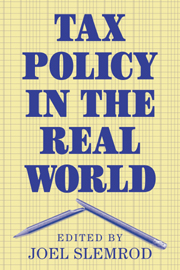Book contents
- Frontmatter
- Contents
- List of contributors
- 1 The real world of tax policy
- 2 Federal tax reform
- The corporate income tax: economic issues and policy options
- Changing views of the corporate income tax
- The American retail sales tax: considerations on their structure, operations, and potential as a foundation for a federal sales tax
- Would tax evasion and tax avoidance undermine a national retail sales tax?
- Life under a personal consumption tax: some thoughts on working, saving and consuming in Nunn-Domenici's tax world
- Living with the flat tax
- The international implications of consumption tax proposals
- 3 Federalism and subfederal taxes
- 4 Principles, politics, and the professors
- Index
The international implications of consumption tax proposals
Published online by Cambridge University Press: 01 June 2010
- Frontmatter
- Contents
- List of contributors
- 1 The real world of tax policy
- 2 Federal tax reform
- The corporate income tax: economic issues and policy options
- Changing views of the corporate income tax
- The American retail sales tax: considerations on their structure, operations, and potential as a foundation for a federal sales tax
- Would tax evasion and tax avoidance undermine a national retail sales tax?
- Life under a personal consumption tax: some thoughts on working, saving and consuming in Nunn-Domenici's tax world
- Living with the flat tax
- The international implications of consumption tax proposals
- 3 Federalism and subfederal taxes
- 4 Principles, politics, and the professors
- Index
Summary
Several of the current tax reform proposals would replace the U.S. income tax system with a consumption tax. This paper examines how recognizing the international mobility of goods and capital may change the results of a closed economy analysis of these proposals. We consider the effects of the proposed tax systems on cross-border investment and trade, and on international tax administration and compliance problems. We also examine the distribution of the transition incidence of these plans between foreign and U.S. residents, and the possible reactions of other countries to a change in U.S. tax policy of this nature.
The analysis in this paper will focus largely on two of the consumption tax proposals, a “flat” tax, as Representative Armey proposed; and the Unlimited Savings Allowance (USA) tax Senators Nunn and Domenici proposed. The Armey flat tax proposal is modeled on the tax scheme Hall and Rabushka (1983, 1985, 1995) proposed, which we rely on for details of the plan. Under the flat tax scheme, individuals are taxed only on their wage income (including pensions) and businesses are taxed on their cash flow measured as sales less purchases, including capital purchases and wages. Under the USA tax plan, individuals face a consumed income tax, i.e., a tax on income less savings (plus dissavings). At the business level, the USA tax imposes a substraction method value-added tax (VAT), i.e., tax is paid on sales less purchases, where purchases include capital purchases but not wages.
- Type
- Chapter
- Information
- Tax Policy in the Real World , pp. 111 - 140Publisher: Cambridge University PressPrint publication year: 1999
- 2
- Cited by



